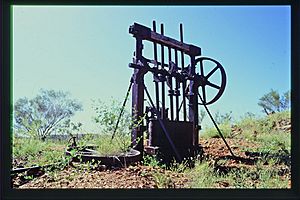Bower Bird Battery facts for kids
Quick facts for kids Bower Bird Battery |
|
|---|---|

Ruins of the Bower Bird Battery, 1993
|
|
| Location | Mount Isa Mining District, Mount Isa, City of Mount Isa, Queensland, Australia |
| Design period | 1870s - 1890s (late 19th century) |
| Built | c. 1895 - c. 1909 |
| Official name: Bower Bird Battery | |
| Type | state heritage (archaeological) |
| Designated | 13 December 2002 |
| Reference no. | 601863 |
| Significant period | 1873, c. 1895 (fabric) 1895-c. 1909 (historical) |
| Significant components | forge/blacksmithy, mullock heap, mine - open cut, wall/s, battery/crusher/stamper/jaw breaker, terracing, machinery/plant/equipment - mining/mineral processing |
| Lua error in Module:Location_map at line 420: attempt to index field 'wikibase' (a nil value). | |
The Bower Bird Battery is an old gold processing site in the Mount Isa area of Queensland, Australia. It was built around 1895 and used until about 1909. A "stamper battery" is a machine that crushes rocks to get valuable minerals, like gold, out of them. This site is important because it shows how gold was mined in Queensland a long time ago. It is now protected as a heritage site on the Queensland Heritage Register.
Contents
What is the History of Bower Bird Battery?
How Gold Mining Started at Bower Bird
The area around Bower Bird was officially named a goldfield on 5 September 1895. Later, in 1913, it became part of the larger Cloncurry Gold and Mineral Field. This region has rugged hills made of hard rock, with streams flowing into the Leichhardt River.
People first found gold at Bower Bird between 1870 and 1872. Early gold seekers, called fossickers, were already looking for gold here before 1880. Maps from 1882 even showed a "Bower Bird Goldfield."
The First Gold Discoveries
The first important gold vein found was called the Victoria. In 1884, rocks from this vein were crushed. They produced 103 ounces of gold from about 17 tons of ore. This ore had to be carried a long way to another crushing machine near Cloncurry.
Building the Bower Bird Battery
The Bower Bird Battery itself was likely set up in 1895. It had five stamps (heavy hammers for crushing), four berdans (grinding machines), and a concentrator (to separate gold). The main stamper machine was quite old, made in 1873.
Between 1895 and 1897, the Victoria reef was the main producer. It officially yielded 811 ounces of gold from 930 tons of ore. The mine might have been left empty because of a drought. It's not clear if the battery kept working on ore from other nearby gold veins.
The Town and Later Use
By 1895, a small town had grown up near the battery. It had three stores, two hotels, and a post office. The post office closed in 1901.
In 1904, reports said the battery shed had burned down. But the battery was probably rebuilt. In 1909, the Victoria Reef mine reopened and produced more gold. Records suggest the battery was fixed up in 1908. A government geologist visited in 1937 but didn't report on the battery.
What Can You See at Bower Bird Battery Today?
The Bower Bird Battery site is on a small flat area next to a hill. You can still see an almost complete five-head stamp battery. This is the main machine used for crushing rocks. There are also parts of the old battery shed.
Mining Workings and Camp Site
Many old mining holes and tunnels are spread out along the gold vein where the battery stands. About 100 meters east of the battery, there's an old camp site.
Near the stamp battery, you can find parts of the old battery shed. There are also other pieces of machinery, like two berdan pans and a large wheel. You can also see a forge, which was like a furnace for heating metal. North of the stamps, there are many old digging areas and piles of waste rock. To the east, there's a shallow open pit mine.
What the Camp Site Looks Like
The camp site has two low stone wall structures. Each has an outdoor fireplace. There are also other low rock walls. These stone structures suggest that the miners lived in tents or shelters made of branches, with the stonework forming the bottom walls. Some recent digging for exploration has damaged parts of the camp site.
Surviving Equipment
The main pieces of equipment still at the site include:
- A five-head stamp battery and its frame. It was made by P.N. Russell & Co. Engineers in Sydney in 1873.
- Two berdan pans, which were used for grinding.
- The base of a grinding pan.
Why is Bower Bird Battery Important?
The Bower Bird Battery was added to the Queensland Heritage Register on 13 December 2002. This means it is a special place that needs to be protected.
Showing Queensland's History
The battery helps us understand how gold mining developed in Queensland. It's also an example of the temporary towns that popped up when people found gold.
A Rare Example of Mining History
This site is rare because it's one of the few remaining examples of a gold battery and mining camp in a remote, dry area.
Learning from the Past
The area around the battery has many old mining workings and simple stone camp sites. These are mostly untouched and could be from the 1890s. Studying them could teach us more about Queensland's history.
A Unique Stamp Battery
The five-head stamp battery at Bower Bird was built in 1873. This makes it one of the oldest known batteries in North Queensland. It is also the only complete stamp battery left in Western and North-West Queensland, and it might be the oldest one still standing in all of Queensland.

